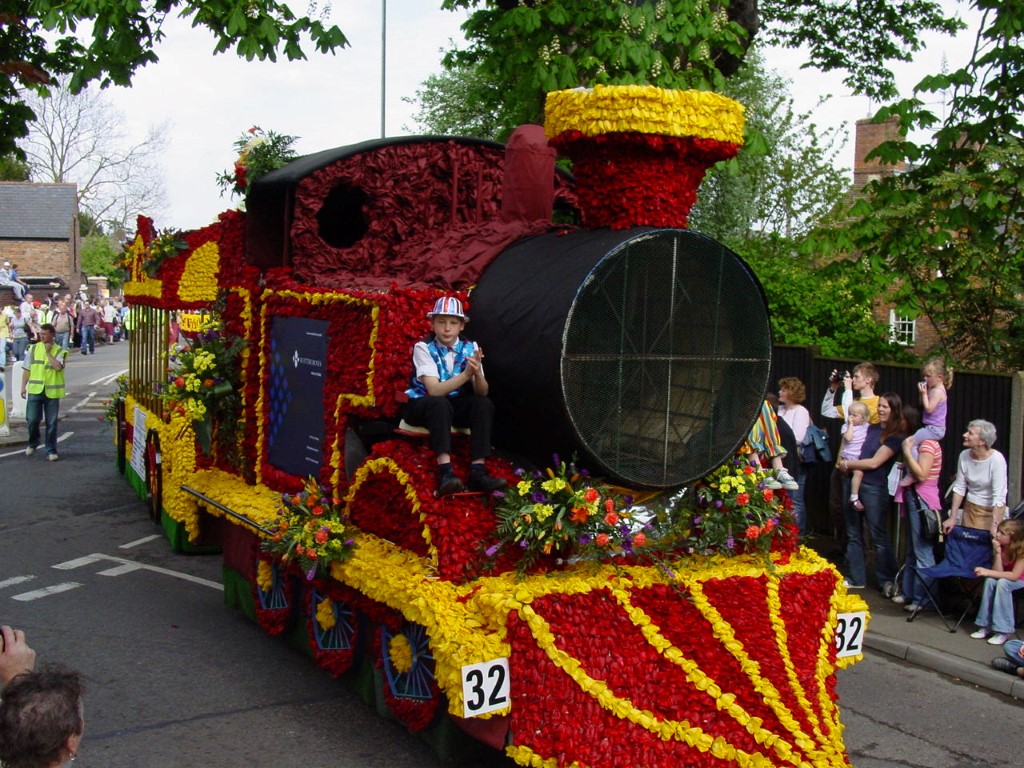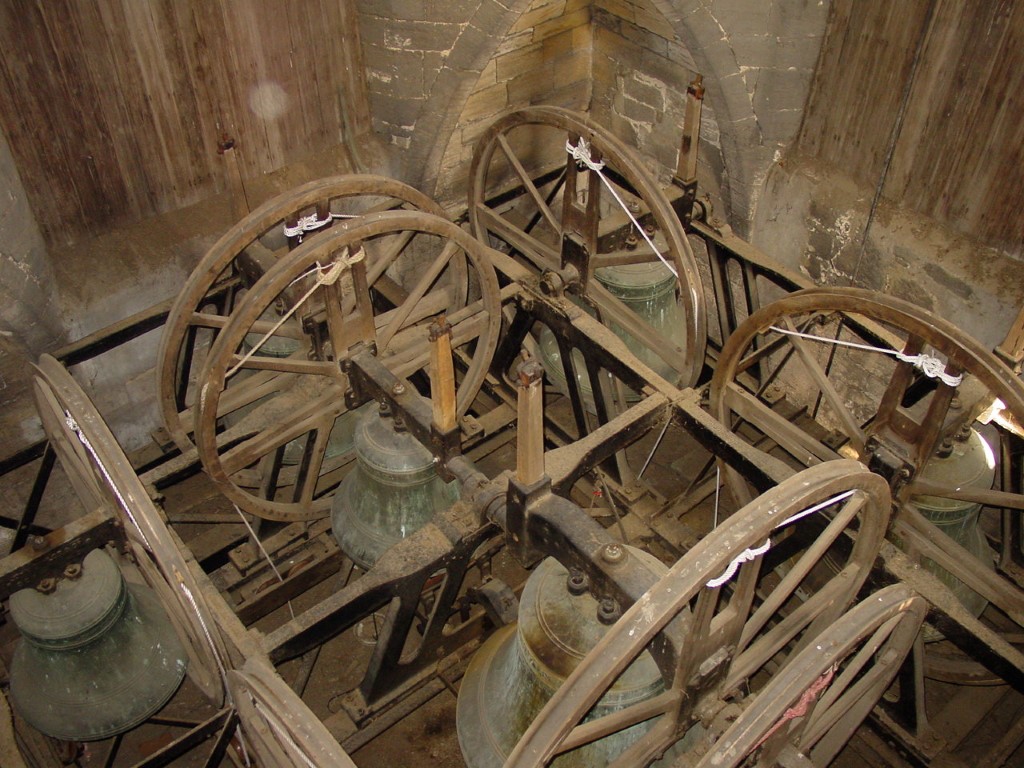Every Spring in the Fenland town of Spalding, large crowds are drawn to the annual flower festival when many richly decorated floats covered in tulip heads slowly wind its way through the town. For the spectator and the photographer it is a very colourful event and you need to take up your perch well before the procession starts. Having said that, we made a family weekend of it a few years ago and decided to explore what the Fens had to offer. One good thing about the weekend of the Spalding Flower Festival is that many of the local churches put on flower displays and so you can spend all day visiting as many churches as you wish.

One of the floats in the Spalding Flower Parade. There are normally at least thirty such floats and each one has a theme.
The Fens are probably one of the least walked areas in Britain but have their own attraction. Its true there is a lack of footpaths, and those that do exist tend to run in straight lines either along the boundaries of very large fields or beside dead straight water channels. Having said that, Spring is a good time to visit this area as some of fields are full of tulips or daffodils which can give a vivid display of colour which is almost unique in this country. Another plus point is that despite the area being as flat as a pancake, there are normally wide open vistas and cloudscapes which have its own attractions.
Having spent a day in Spalding we had a second full day to explore and go on a walk. Starting out from Long Sutton, I was going to follow a walk taken from a guide book. With an overnight thunderstorm, the air still felt muggy on this Sunday morning and it seemed almost as if the thunder might return. The open landscape of the Fens was probably not the best place to get caught out in a thunderstorm but nevertheless we opted to set out from the large village of Long Sutton.
The village which is thankfully now bypassed by the A17 has some fine Georgian buildings and was once a quite prosperous trading centre but nowadays it takes on the feel of a quiet backwater. It once had a railway station and local produce could be easily transported to major conurbations. On a darker side, the village was once home fo5r a brief period to the infamous highwayman Dick Turpin who lived under the alias name of John Palmer.

Tulips in the churchyard at Long Sutton, just one of hundreds of displays in different churchyards in the area.
We set out on this walk by crossing the churchyard then the recreational field before taking a path north east. The church bells are ringing for the Sunday morning service but other than that it is quiet. Veering east later we pause to photograph a large field of daffodils. Soon, a right turn takes us onto Hospital Drove which we will follow due south to reach the South Holland Main Drain, one of the principal water drainage channels in the area. At least this road is very quiet and is dead straight in this very flat countryside. En route we cross the A17 and later join a track to reach the South Holland Main Drain. This waterway despite being very straight at least breaks up the flatness of the surrounding countryside and there is an embankment to walk along. Furthermore it makes a good spot to stop for our morning break. We now follow the embankment west for a good mile and cross the A1101 on the way.
Heading north towards Long Sutton the way is more interesting as we follow a minor road on top of the old Sea Bank. In mediaeval times this was the coastline and over the course of several centuries the land has been drained so that The Wash now lies several miles to the north. Walking this raised road gives us a better view of the surrounding countryside and there are several cottages dotted along the road.
Later we join the B1390 briefly then take a field path bordering ditches and watercourses. The A17, is now much busier and we cross this road again then follow a faint path back to Long Sutton.

St Mary’s Church Long Sutton. My son and I climbed to the top of the spire to get a view from the hatch door which can be seen open just below the top.
With a picnic lunch in the churchyard it is time to explore the village church. With my wife and daughter busy taking in the flower display, I note that the church tower is open to the public. Now I can’t resist a climb up a church tower and this is a rare opportunity at this particular church. My son joins me for the ascent up the solid church tower and reaching the top of the tower there is then an opportunity for a small charge, and at your own risk the climb the interior of the spire.
The spire of St Mary’s Church, Long Sutton was built to a similar design to the famous twisted spire at Chesterfield but the spire at Long Sutton is not twisted. The 13th century lead covered spire is said to be the highest and oldest in England and possible Europe of this type.

The belfry at St Mary’s Church, Long Sutton at the top of the tower. The next photograph shows the climb ahead of us.

The medieval latticework within the spire of St Mary’s Church, Long Sutton. Ladders can be seen at the top left and centre right at the top of the photograph.
Looking up it is a daunting task to climb up through the wooden medieval latticework on a series of wooden ladders with nothing to stop a fall. There are few handrails and it is dark as I follow my son up a series of steep wooden ladders. Every so often we pause on a small airy wooden platform before tackling the next ladder. Far below is an unprotected drop to the belfry, and as we climb higher the interior becomes narrower as we squeeze from one ladder to the next. Nearing the top of the interior I estimate that there is a drop of a good ninety feet to the belfry and we ensure we have a good grip of the ladder.
The top comes quite suddenly and we take it in turns to squeeze past one another on the small platform where there is an open hatch at the top of the spire giving us a rewarding view of the Fens. During the Second World War, a lookout was posted on top of the spire to report on enemy bombers crossing the area. What a job!
After ten minutes at our lofty perch and with several photographs taken it is time to descend, and just as a point of comfort our guide tells us not to put two feet on any one rung on the way down as occasionally they break. Well that is a good time to tell us! I had incidentally noticed on the way up that many of the rungs had been replaced. The descent proves more difficult as at each dark platform you need to get down on hands and knees to feel with your feet where the top of the next ladder is. Back on terra firma we head for the good old fashion village hall for a good cup of tea. What an end to a walk!
The Spalding Flower Festival will be held this year on the 8th and 9th of April.



